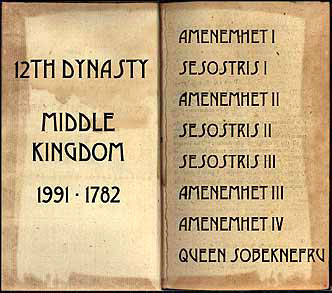|
Married to Amenemhet IV, who was possibly also her brother and on his death she became ruler of Egypt. Like Amenemhet IV there are very little records of her reign now remaining. Statues of her were found in the Faiyum and she added to the Labyrinth of Amenemhet III.
Sobeknefru had a very brief reign of 4 years (she may have actually been co-regent with Amenemhet IV), she has been identified with a pyramid near Dahshur (with similar problems about truly identifying the pyramid with her as with identifying Amenemhet IV and his pyramid).
Sobeknefru
One of the few, and possibly
the first confirmed female pharaoh of Egypt, who's name means "Beautiful
of the God Sobek." Sobeknefru was the wife and possible half
sister, of Amenemhet IV ("Amun is at the Head") who had
ruled Egypt for only 8 or 9 years following the successful 45 year reign
of his father, Amenemhet III. Upon Amenemhet IV's death Sobeknefru
assumed the throne for a reign of less then 4 years before her death.
Its currently debated whether or not she was Amenemhet III's wife, a
rival or a regent for an infant son.
The fact that her name also
appears in conjunction with Shedty which could link her with
being involved in the creation of a religious center in Fayum called
Shedet. Shedet was a cult that worshiped the crocodile god
Sobek, so it is possible that the priests of this old local deity
backed her bid for the throne. This could also explain her break with
tradition by assuming a crocodile name as a pharaoh for the first time.
In either event, her tomb and mummy has not been found, however, there
is remnants of a pyramid near Dahshur that could be hers. If that
is true that would indicate the possibility that later in her rule she
left the Fayum for the traditional capitals of Memphis and/or
Heliopolis. Where Sobeknefru actually maintained her capital
throughout her reign is unknown.
Texts associating her with
her father have also survived. She completed her fathers mortuary
temple, the Labyrinth of Amenemhet III, where her name
appears many times (of her husband, Amenemhat IV? nothing.). Of these
artifacts, some bear female titulary and others male. Thus far no
complete depiction of her has in any form. However, there is an intact
depiction of a female pharaoh with a unusual crown and wearing a
Hebsed cloak at the Metropolitan Museum of Art in New York. Some
think that it could be her based solely on the style of the statue.
|


